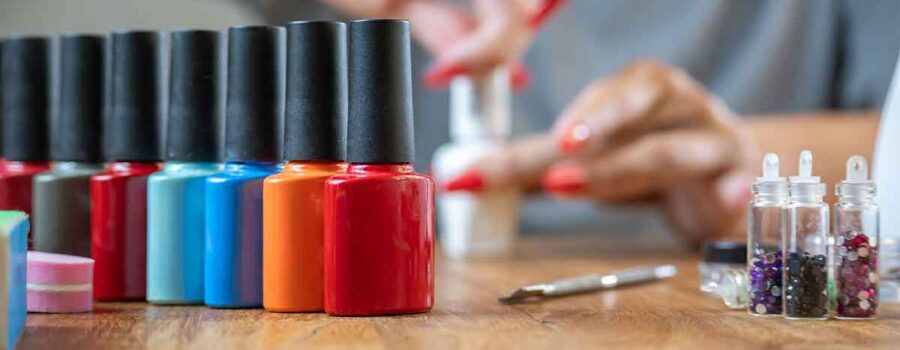If you have shellac on your nails right now, here is why you should avoid your next appointment. Like many products on the market, nail polish companies are not required to list their ingredients. This leaves us often clueless about what we’re putting on our bodies. Not only do we breathe in the nail polish (not to mention removers, top coats, and treatments) while we paint our nails, but our nails and skin can also absorb the chemicals in nail polish.
Some studies suggest there isn’t cause for concern as the exposure to these toxins is generally small. However, what about those who paint their nails every week or more often? And even more so, what about the nail technicians who spend so much time working closely with these products daily?
The Hidden Dangers of Nail Polish
Many women enjoy painting their nails as a fun and temporary way to change their look. Whether opting for bold, sparkly shades that reflect their personality or choosing “professional” nude tones, knowing what ingredients are in these products to make safe choices is essential. This awareness is even more critical for nail technicians and others who work closely with these products daily. While major policy changes are needed to ensure safety, understanding the potential toxins in nail polish empowers women to:
- Make safer personal choices for themselves and their loved ones.
- Advocate for safer conditions for salon workers through grassroots efforts.
Here are 12 of the top toxins found in nail polish:
- Dibutyl Phthalate (DnBP): Phthalates, including DnBP, are known endocrine disruptors. They have been linked to a range of health issues such as hormone changes, diabetes, and thyroid irregularities. These compounds interfere with the body’s natural hormone functions, potentially leading to long-term health problems.
- Toluene: Toluene exposure can cause eye irritation and has been associated with more severe effects such as kidney and nervous system damage. This chemical is commonly found in nail polish and can be harmful if inhaled regularly. Prolonged exposure can lead to serious health complications over time.
- Formaldehyde: Formaldehyde is a known carcinogen, meaning it can cause cancer. It is often used in nail polish as a preservative or hardener. Even in small amounts, exposure to formaldehyde can pose significant health risks, including respiratory issues and skin irritation.
- Formaldehyde Resin: A derivative of formaldehyde, formaldehyde resin is frequently used in nail polish as a hardening agent. While it helps achieve durable manicures, in large doses, it can be a skin allergen. Prolonged contact with this resin can lead to allergic reactions and other skin conditions.
- Camphor: Camphor is known to cause seizures and disorientation in high doses. It is also responsible for turning nails yellow by stripping them of their nutrients. Regular exposure to camphor can lead to more severe neurological effects over time.
- Triphenyl Phosphate (TPHP): TPHP is an endocrine disruptor that can impact reproductive and developmental health. This chemical can interfere with hormone regulation, affecting various bodily functions. Its presence in nail polish is concerning due to its potential long-term health effects.
- Xylene: Xylene is a volatile chemical that can irritate the skin, eyes, and respiratory tract. It is absorbed rapidly when inhaled, posing a risk of immediate and potentially severe health issues. There is also concern that xylene may be carcinogenic, adding to its potential dangers.
- Ethyl Tosylamide/Epoxy Resin: Rated as a low hazard by the EWG, this chemical is still controversial. It acts as an antibiotic, raising concerns about contributing to antibiotic resistance. Even with its low hazard rating, its use in nail polish remains a point of concern for long-term health.
- Lead: Lead exposure is harmful to almost every organ system in the body. It has been linked to numerous health effects, including disruption of the HPA axis and damage to the brain and kidneys. Even small amounts of lead can have severe and lasting health impacts.
- Hydroquinone Monomethyl Ether (MEHQ/HQ): This chemical can cause skin and eye irritation. It is used in nail polish to enhance certain properties, but its irritating effects are a significant downside. Prolonged exposure can lead to more serious dermatological and ocular issues.
- Methylisothiazolinone (MIT) / Methylchloroisothiazolinone (CMIT): These preservatives are linked to lung toxicity and allergic reactions. They have also been associated with potential neurotoxicity, making their use in nail polish particularly concerning. Regular exposure to these chemicals can pose serious health risks.
- Parabens: Parabens are common preservatives that mimic estrogen in the body, acting as endocrine disruptors. They are used to extend the shelf life of products but pose significant health risks. Long-term exposure to parabens has been linked to hormonal imbalances and other health issues.
Understanding the potential dangers lurking in nail polish is crucial for making informed choices about what we put on our bodies. While the cosmetic industry often downplays the risks, it’s important to stay vigilant and prioritize our health. Opting for nail polish brands that are transparent about their ingredients and choosing products labeled as “10-free” or higher can significantly reduce exposure to harmful chemicals. For those who love the creativity and expression that comes with beautifully painted nails, there are safer alternatives available that don’t compromise health for aesthetics.
Here are a few brands known for their commitment to non-toxic formulations:
- Klee: Klee offers water-based nail polishes that are safe and non-toxic, ideal for kids and adults. Their products are free from harsh chemicals and provide a gentle, colorful alternative to traditional nail polish.
- Zoya: Zoya nail polishes are 10-free, meaning they omit 10 of the most common toxic ingredients found in many conventional nail polishes. They offer a wide range of colors and finishes.
- Ella+Mila: This brand is also 17-free. Ella+Mila provides a variety of stylish and trendy shades, ensuring that there’s something for everyone.
- Côte: Côte polishes are 10-free. They pride themselves on producing high-quality, safe nail polish that doesn’t compromise on performance.
- Sundays: Known for being 10-free. Sundays also focuses on creating a relaxing nail care experience with their range of classic and modern colors.
- Pacifica: Pacifica offers 16-free nail polish, ensuring that their products are free from many of the harmful chemicals.
- Tenoverten: Tenoverten nail polishes are 8-free. They are dedicated to providing high-quality nail products.
Raising awareness and advocating for better safety standards in the beauty industry is essential. By supporting brands committed to non-toxic formulations and voicing concerns about the current regulations, consumers can drive change. This grassroots effort can lead to safer working conditions for salon workers who are continuously exposed to these chemicals and help reduce the overall health risks associated with nail polish.
In conclusion, while having perfectly manicured nails can be a delightful form of self-expression, it’s vital to be mindful of the products used. Making educated choices about nail polish can protect personal health and contribute to broader industry changes, ensuring that beauty doesn’t come at the cost of well-being.
References:
- Non Toxic Revolution. (n.d.). How toxic is nail polish? (And what to use instead!) Non Toxic Revolution. Retrieved May 17, 2024, from https://www.nontoxicrevolution.org/blog/how-toxic-is-nail-polish-and-what-to-use-instead
- Occupational Safety and Health Administration (OSHA). (n.d.). Toluene – Health effects. OSHA. Retrieved May 17, 2024, from https://www.osha.gov/toluene
- National Center for Biotechnology Information (NCBI). (n.d.). Formaldehyde – Hazardous substances data bank. PubChem. Retrieved May 17, 2024, from https://pubchem.ncbi.nlm.nih.gov/compound/Formaldehyde
- Yapabeauty. (n.d.). Formaldehyde resin in nail polish. Yapabeauty. Retrieved May 17, 2024, from https://www.yapabeauty.com/
- Palate Polish. (n.d.). What’s in your nail polish?. Palate Polish. Retrieved May 17, 2024, from https://www.palatepolish.com/
- Environmental Working Group (EWG). (n.d.). Triphenyl phosphate. EWG. Retrieved May 17, 2024, from https://www.ewg.org/
- Agency for Toxic Substances and Disease Registry (ATSDR). (n.d.). Xylene – ToxFAQs. ATSDR. Retrieved May 17, 2024, from https://www.atsdr.cdc.gov/toxfaqs/tf.asp?id=296&tid=53
- Environmental Working Group (EWG). (n.d.). Lead in cosmetics. EWG. Retrieved May 17, 2024, from https://www.ewg.org/
- PubChem. (n.d.). Hydroquinone monomethyl ether. PubChem. Retrieved May 17, 2024, from https://pubchem.ncbi.nlm.nih.gov/compound/Hydroquinone-monomethyl-ether
- Campaign for Safe Cosmetics. (n.d.). Isothiazolinones. Safe Cosmetics. Retrieved May 17, 2024, from https://www.safecosmetics.org/get-the-facts/chemicals-of-concern/isothiazolinones/
- Campaign for Safe Cosmetics. (n.d.). Parabens. Safe Cosmetics. Retrieved May 17, 2024, from https://www.safecosmetics.org/get-the-facts/chemicals-of-concern/parabens/
- BelleTag. (n.d.). Is nail polish toxic: The toxic truth about nail polish and your health. BelleTag. Retrieved May 17, 2024, from https://www.belletag.com/beauty/nail-polish-toxic-ingredients
- The Healthy. (n.d.). Is your nail polish toxic?. The Healthy. Retrieved May 17, 2024, from https://www.thehealthy.com/nails/nail-polish-toxins/
- Harvard T.H. Chan School of Public Health. (n.d.). Nontoxic nail polish may still contain toxic chemicals. Retrieved May 17, 2024, from https://www.hsph.harvard.edu/news/features/nontoxic-nail-polish-may-still-contain-toxic-chemicals/








